A lot of modern computers already come with high-quality built-in webcams. But there are still many reasons to use a standalone webcam. Maybe you’re using a monitor that doesn’t come with a webcam. Maybe you want better color and clarity than the stock camera on your machine. Or maybe you want to get a better way. Regardless, webcams are alive and well as peripherals, and are going to be with us for the foreseeable future.
Now, you could always just set your webcam on your desk or table. But that would limit your options, and could get shaky as you move your mouse or type. To get the best possible quality, your best option is to use a webcam stand or mount.
Generally speaking, there are two different types of webcam stands: fixed and flexible. Fixed stands generally clip onto your monitor or another stationary object, although some incorporate a tripod instead. Flexible stands generally clamp onto your desk or monitor, but feature some kind of flexible arm that can be moved around without unclipping the stand.
Today, we’re going to be looking at this second variety of webcam stand. We’ve collected three of the best flexible webcam stands available, and compared all their features. Here’s what we found, and how they stack up.

Why Use a Webcam Stand?
There’s an old engineering truism that form follows function. What this means is that if you’re going to design something, you need to know its purpose before you begin. Conversely, if you’re trying to evaluate whether or not something is any good, you need to know what you’re looking for. Here are a few benefits you should be expecting from a quality flexible webcam stand.
To begin with, your most obvious benefit is that you’re eliminating wobble. And while there’s a lot more to a good webcam stand than stability, any stand worth its salt still needs to be stable. Stability isn’t just about wobbly video, though. The less your camera moves, the better it will stay in focus. As a result, a stable webcam stand will allow you to produce clearer, sharper video.
A stand also allows you to capture photos and video from a variety of angles. This is what separates a flexible stand from a tripod or a simple clip-on mount. You can even move the camera around during a video without dismounting it, although obviously there will be limitations to your mobility. But even for simple, stationary use they can be quite useful. Suppose you’re a game streamer, and you want to be recorded from a specific angle. With a traditional stand or mount, you won’t typically be able to get that perfect diagonal angle you were hoping for.
Finally, you’ll want to think about how much space you’re dealing with. On the surface, a bigger stand with more reach seems better. But if you’re on a small desk or don’t have a lot of clearance, a smaller stand might actually be a better choice.
Smatree Flexible Jaws Clamp Webcam Holder
The Smatree Flexible Jaws Clamp Webcam Holder has a gooseneck design. This means that rather than being hinged as you might expect, it flexes along its entire length. This makes it a great choice if your camera’s positioning requires you to make multiple, short bends. It also provides a convenient way of shortening the stand, since you can coil it around to save space. When fully extended, it measures 13.4 inches in length, or slightly shorter than the average monitor. As such, it will film most people at a slight upward angle when clamped on a standard-height desk.
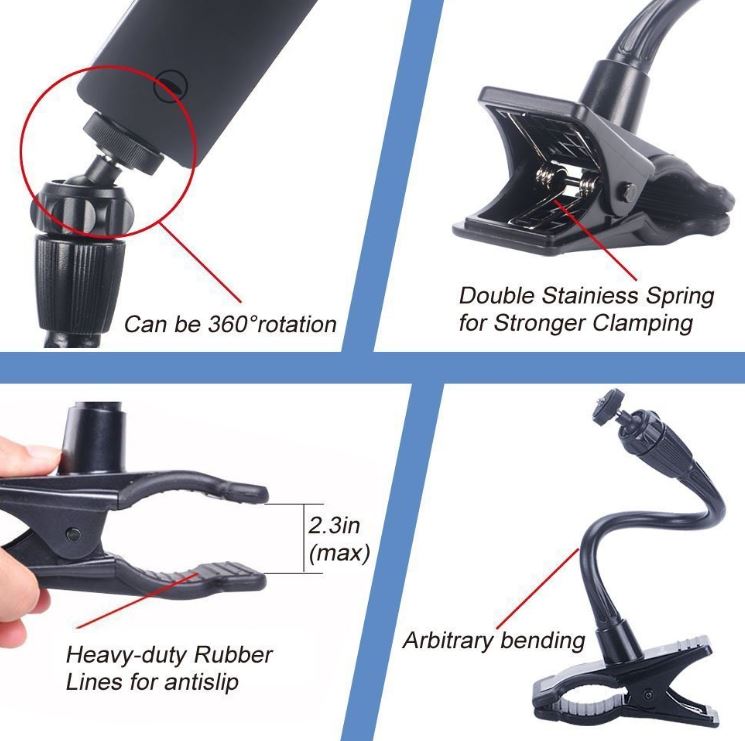
The clamp itself opens to a width of 1.8 inches, and looks more or less like a standard alligator clip. It’s constructed from ABS plastic, with comfortable ridges on the back that make it easy to grip.
It’s spring-loaded, and the spring is constructed from tough stainless steel. On the front end, the “mouth” side, soft rubber tips prevent it from damaging wood or paint finishes. The manufacturer recommends mounting it on something that isn’t going to vibrate, so consider your gaming and streaming habits when you make your decision. If you’re not sure about your desk, put a glass of water down while you stream or game. If the surface of the water is swishing back and forth, you’re shaking your desk. Try mounting your camera on an adjacent piece of furniture instead.
In terms of compatibility, the Smatree has a lot to offer. It comes with not one, but two different tips for mounting various types of cameras. Like most webcam mounts, it features a simple, ¼-inch screw mount. This tip is going to be compatible with a wide variety of webcams, including Logitech and Microsoft webcams, as well as GoPro cameras. In addition, the Smatree camera mount includes a tripod adapter. If your camera requires a tripod mount, you’ll appreciate this extra compatibility.
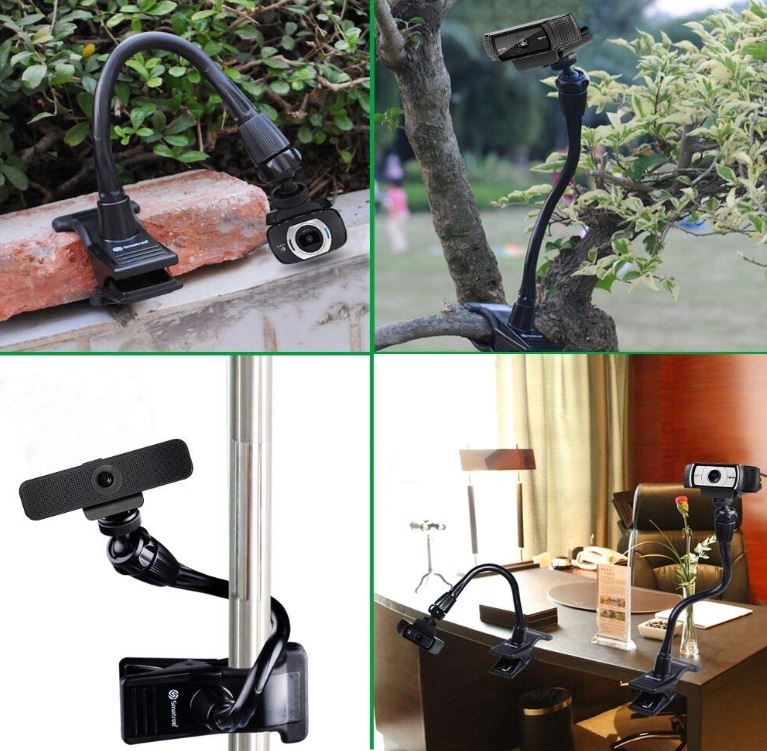
With the exception of the clamp and some of the mounting apparatus, the Smatree is constructed from anodized aluminum. It weighs 10.4 ounces, which is surprisingly sturdy for a device of this size and slenderness.
The overall weight capacity isn’t listed, but we’ve seen people put a 10-ounce lamp on the end without causing the neck to flex or droop. This is heavier than any webcam we’ve ever seen on the market, so you should be just fine. That said, if you were thinking of using the tripod adapter to mount a heavier optical camera, you should reconsider.
The mounting head has a ball bearing design, which means it can be rotated 360 degrees. However, you’ll need to take care to operate it correctly to avoid damaging it. There’s a hemispheric nut over the top of the ball bearing, with a large opening for the shank to come out of the top.
When this nut is screwed down all the way, it compresses an inner rubber ring. This ring, in turn, puts pressure on the bearing, holding it in place. When you loosen the nut, the rubber ring releases its pressure, and the bearing can swivel freely. It can even rotate 360 degrees, so you can truly point your webcam in any direction.
Anivia Webcam Desktop Clamp
The Anivia Webcam Desktop Clamp is a sturdy steel webcam mount that looks like something you’d expect to see in a professional studio.
It consists of two sections, with hinges at the bottom, middle, and top. This allows for plenty of flexibility, so you can position your camera just about anywhere. When fully extended, the boom measures 31.5 inches in length.
This makes it a great choice if your clamping position is a couple of feet from your camera. For example, if you host a podcast and you’re bringing on a guest, you may need to reposition your equipment. The boom is also foldable, which makes it easy to store and transport.
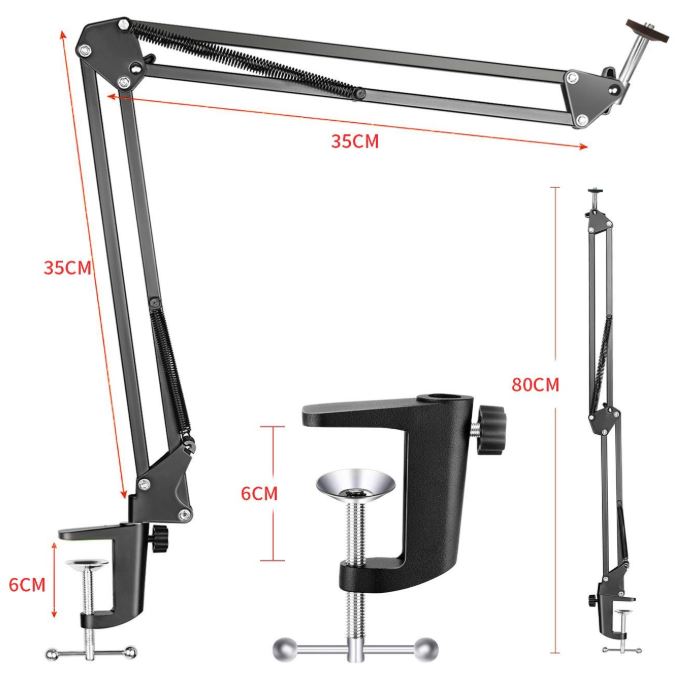
The desk clamp on the Anivia can best be described as impressive. It looks like a C-clamp you’d buy at the hardware store, and it has the ruggedness to match. Like the boom arms, it’s constructed from black stainless steel, although the opening screw is plain stainless.
When fully opened, the opening measures 2.05 inches in width. At that size, you’ll be able to mount it on just about any desk imaginable. Be careful, though: while the top of the clamp has a rubber guard, the bottom doesn’t. Put a piece of cloth over it to avoid damaging the underside of your furniture.
One neat thing about the clamp is the way the boom mounts in it. A round shank on the bottom of the boom is inserted through a sleeve on the back of the clamp. As a result, you can pivot the boom in any direction. When it’s facing the way you want, a simple set screw prevents the boom from spinning.
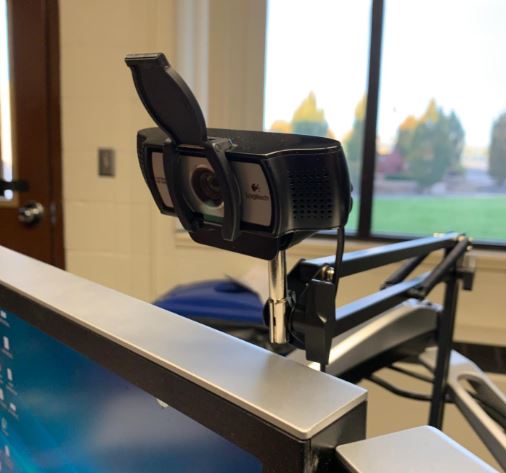
If you’re looking for a high-capacity webcam stand, look no further. The dual boom arms are sturdy enough to support up to 4.4 pounds, which is more than enough even for a heavy, professional-grade camera.
It’ll certainly carry a more vanilla webcam just fine, but it’s good to have options. In addition, each of the hinges is supported by a pair of heavy-duty steel springs, for added reinforcement. All of the hardware is built to the highest standard, including heavy duty side plates on the hinges. Even the screws look and feel sturdy.
The Anivia is compatible with almost any camera. The mounting tip is a simple, ¼-inch screw mount, which will work with most brands. Better yet, you can still use this mount. if your camera doesn’t have a screw hole on the bottom.
Anivia has included a threaded dome you can glue on the bottom of your camera, which works with any brand. The threaded rod does not pivot like the mounting tip on the Smatree. However, as mentioned, it does swivel up and down on a hinge. Once it’s in position, a set screw on the side keeps it from drooping.
Pipishell 25-inch Webcam Stand
In a lot of ways, the Pipishel 25-inch Webcam Stand is similar to the Smatree we started off with. To begin with, it’s also a gooseneck-style stand.
However, it’s much longer than the Smatree, measuring 25 inches in length. That’s enough to get up over the top of most monitors if you want a more traditional angle. Alternatively, you can position the camera just about any way you want, since the gooseneck is incredibly flexible. In situations where you need less length, there’s a simple solution. Just coil the neck up or bend it into an S-shape.
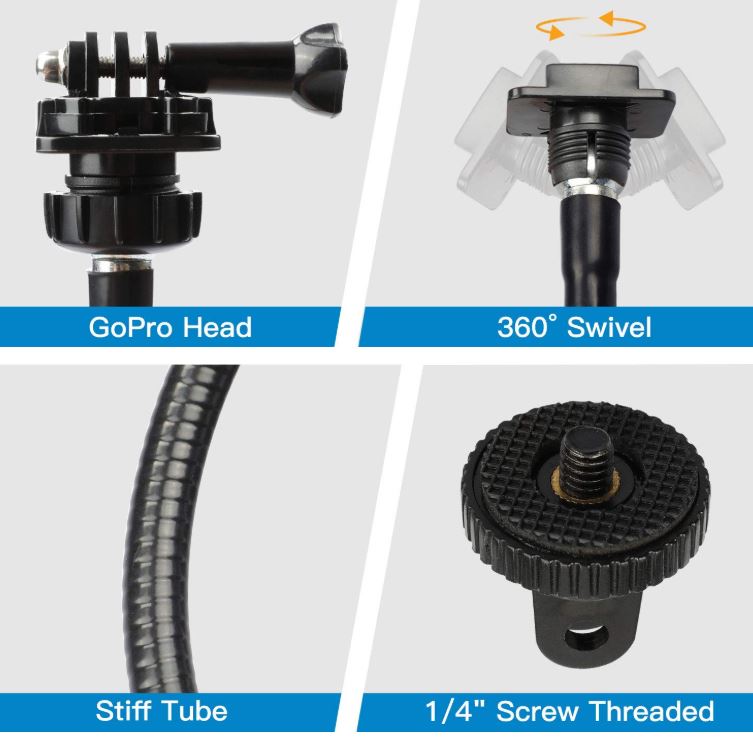
Another similarity to the Smatree is the way the Pipishell mounts to your desk. It utilizes a sturdy, ABS plastic alligator clamp. But once again, the Pipishell stand’s is bigger. It opens to a whopping 2.3 inches. Short of a heavy butcher block, we’re hard-pressed to think of any piece of furniture that’s this thick.
The back of the alligator clip has low ridges that prevent your fingers from slipping. On the inside of the jaws, a pair of foam pads protect your furniture from scratches. They also prevent the clamp from slipping off over time. The spring and hinge in the clamp are made of stainless steel, so we don’t have any concerns about durability.
The tip of the Pipishell 25-inch Webcam Stand features a standard ¼-inch adapter, which will fit virtually any webcam. This includes almost all Logitech and Microsoft webcams, as well as many others.
You can also attach a tripod mount if you so desire, but none is included. One other nice extra feature is that Pipishell includes a GoPro mount in the package. It’s a standard 3-tab hinged mount, which fits most models of GoPro camera. This includes the entire Hero line, from 1 all the way through 7. If you want to mount just about anything on your camera stand, the Pipishell is a solid choice.
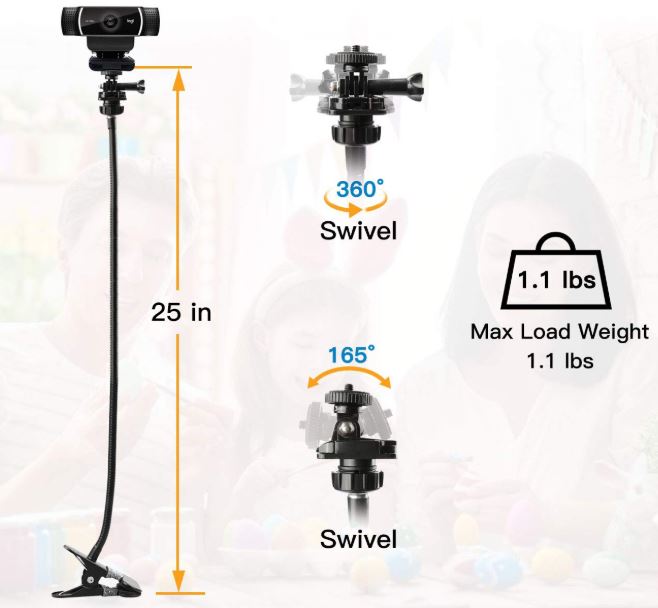
The stand and clamp together weigh in at 14.1 ounces, or just under a pound. It has a solid feel in your hands, with plenty of heft, which tells us it’s pretty sturdy. The manufacturer’s maximum weight rating is 1.1 pounds, which is enough for almost any webcam.
However, it’s not going to be enough for optical cameras, so limit yourself to the stand’s intended uses. At heavier weights, the gooseneck is liable to sag, which defeats the purpose of having a mount to begin with.
The head of the Pipishell is another area where it’s surprisingly similar to the Smatree. It has a nearly-identical ball bearing design, but be careful when you loosen the nut. It can easily drop off the bottom when it’s loosened, so keep a tight grip while you’re working. There is one significant improvement, though. It’s hinged on the bottom, which allows for swiveling up and down as well as for 360-degree rotation.
Final Verdict
So, how do these flexible webcam stands compare to each-other? Honestly, they make an excellent trio, and each of them serves its own unique purpose.
To begin with, the Smatree Stand is ideal for smaller desks or tight spaces. Because it’s relatively short, it’s not going to take up a bunch of extra space. And it’s well-constructed, too. The ball bearing tip is particularly well designed, and holds well. Finally, the gooseneck can support just about any webcam without drooping. That’s not always a given with a stand of this design.
The Anivia Webcam Stand, on the other hand, is the ultimate choice if you’re looking for professional-grade sturdiness. Its stainless steel construction and spring-loaded hinges are studio quality. And the clamp on the bottom is very secure. You’ll also appreciate the long length, since it gives you more options for where to position your mount.
Last but not least, we looked at the Pipishell Stand. This is a balance between the first two we looked at. On the one hand, it’s relatively long, if not quite as long as the Anivia. On the other hand, it’s lightweight, like the Smatree, with a similar slender design. It also has the widest mounting clamp of the bunch.
Meet Ry, “TechGuru,” a 36-year-old technology enthusiast with a deep passion for tech innovations. With extensive experience, he specializes in gaming hardware and software, and has expertise in gadgets, custom PCs, and audio.
Besides writing about tech and reviewing new products, he enjoys traveling, hiking, and photography. Committed to keeping up with the latest industry trends, he aims to guide readers in making informed tech decisions.

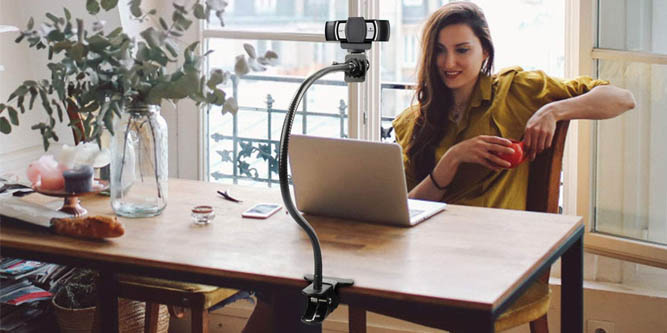
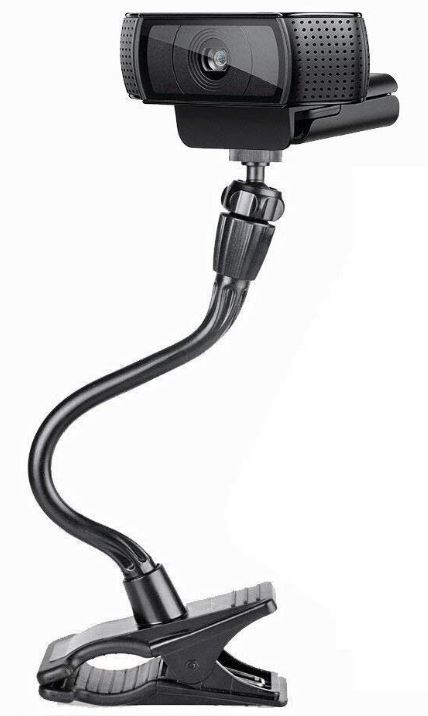
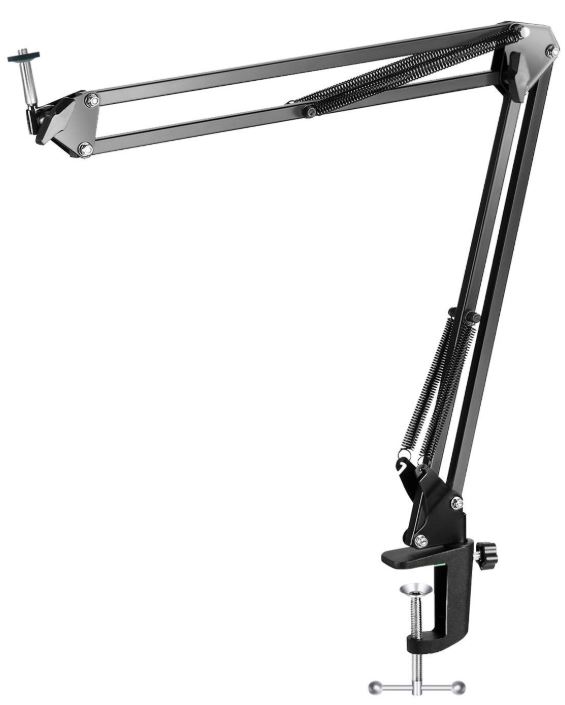
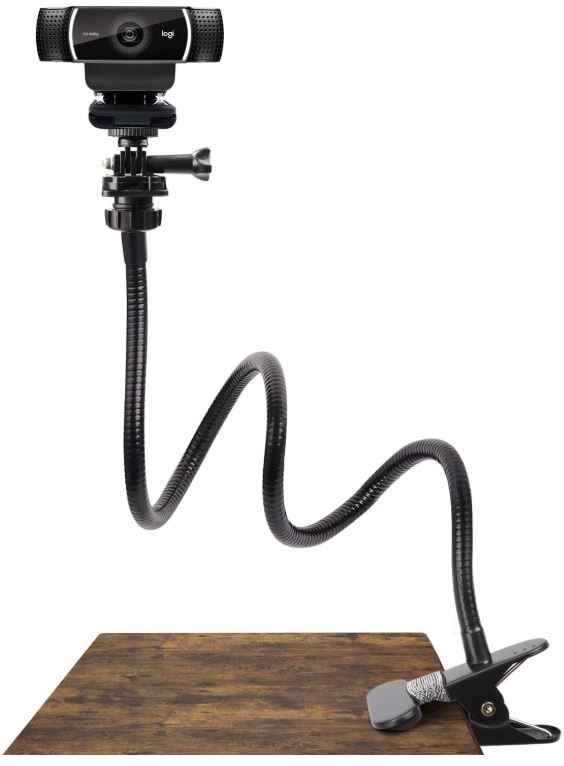
Hello Tech Guru . . I read your article, very well written. I’ve been trying to solve the issue of “not looking people on video calls in the eye.” They see me looking up at my Logitech webcam clipped to the top of my monitor instead of looking them “in the eye” on our video calls. The closest solution I’ve found is called the Center Cam, at Indiegogo.com, sort of an incubator for new product launches, etc. Please let me know if you have a better solution. We basically have to have the camera lense right next to or ON The Face of the person we’re video conferencing with; i.e. the CenterCam hangs down in the middle of your PC monitor next to the person’s face so they think you’re looking them in the eye. Any thoughts? Thank you !